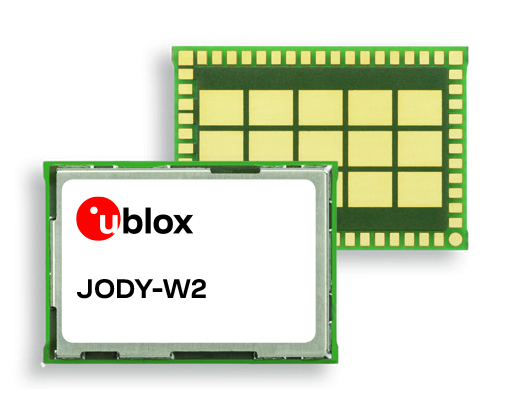Fully encompassing both Wi-Fi 5 & Bluetooth® low energy 5.
 Thalwil, Switzerland – November 26, 2019 – u-blox (SIX:UBXN) continues to strengthen its product offering for both in-vehicle communication and industrial automation, with the introduction of new multiradio hardware. The JODY-W2 (http://www.u-blox.com/en/
Thalwil, Switzerland – November 26, 2019 – u-blox (SIX:UBXN) continues to strengthen its product offering for both in-vehicle communication and industrial automation, with the introduction of new multiradio hardware. The JODY-W2 (http://www.u-blox.com/en/
The highly robust JODY-W2 module incorporates the latest AEC-Q100 qualified wireless system-on-chip (SoC) technology. One variant (non AEC-Q100) is specifically targeting demanding industrial control and monitoring applications, such as patient monitoring, plus surveillance systems, and in-building asset tracking. It has dual band Wi-Fi 5 (802.11ac), covering 2.4GHz and 5GHz frequency channels, as well as built-in WPA3-compliant security mechanisms. Alongside this, it offers Bluetooth 5 capabilities, with both Bluetooth Classic and Bluetooth low energy. To achieve best possible cross-protocol coexistence, there are separate antennas for Bluetooth and Wi-Fi.
Highly optimized for deployment in modern automobile infotainment, telematics systems, and industrial gateways, the JODY-W2 can provide an access point for connection with up to 8 devices, offering enough bandwidth for video streaming via several devices at once. It has the capacity to support parallel transportation of Wi-Fi and Bluetooth signals, and can simultaneously act as an access point and as a station, or conduct peer-to-peer communication.
As this module has the same form factor as the u-blox JODY-W1, (https://www.u-blox.com/en/
As Pelle Svensson, Senior Principal Product Strategy, Product Strategy Short Range Radio at u-blox, explains: “Connectivity is destined to be a key differentiator for car models in the coming years, and u-blox technology is clearly setting the pace here. Through our JODY platform, we are able to meet automotive OEMs’ requirements, and also address the subsequent aftermarket opportunities that are emerging. JODY-W2 sets new performance benchmarks and assures continued data security while coping with the elevated temperatures and challenging operating conditions that are unavoidable in automotive and industrial environments.”






